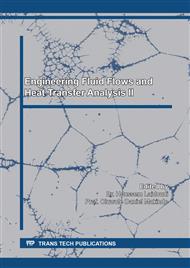[1]
A. H. Alami, A. Abu Hawili, K. Aokal, M. Faraj, M. Tawalbeh, Enhanced heat transfer in agitated vessels by alternating magnetic field stirring of aqueous Fe–Cu nanofluid, Case Studies in Thermal Engineering 20 (2020) 100640.
DOI: 10.1016/j.csite.2020.100640
Google Scholar
[2]
Nagata. Mixing of highly viscous non-Newtonian liquids. International chemical engineering, 12 (1) (1972) 175-182.
Google Scholar
[3]
J. Bertrand, J.P. Couderc, Agitation de fluides pseudoplastiques par un agitateur bipale. The Can.J. Chem. Eng 60, (1982) 738-747.
DOI: 10.1002/cjce.5450600604
Google Scholar
[4]
J. Bertrand, M. Abid, C. Xuerb, Hydrodynamics in vessels stirred with anchors and gate agitators: necessity of 3-D modelling, Chemical engineering Research and design (1992) 377-384.
Google Scholar
[5]
S. Woziwodzki, L. Broniarz-Press, M. Ocho-Wiak, Transitional mixing of shear-thinning fluids in vessels with multiple impellers, J. Chemical Engineering and Technology 33 (7) (2010) 1099-1106.
DOI: 10.1002/ceat.201000121
Google Scholar
[6]
P. Prajapati, F.EIN-Mozaffari, CFD Investigation of the mixing of yield- pseudoplastic fluids with anchor impellers, J. Chemical Engineering and Technology,32(8)(2009) 1211-1218.
DOI: 10.1002/ceat.200800511
Google Scholar
[7]
L. Rahmani, B. Mebarki, B. Allaoua, B. Draoui, Laminar Flow Characterization in a Stirred Tank with a Gate Impeller in Case of a Non-Newtonian Fluid, Energy Procedia 36 (2013) 418 – 427.
DOI: 10.1016/j.egypro.2013.07.048
Google Scholar
[8]
H. Ameur, M. Bouzit, M. Helmaoui, Hydrodynamic study involving a Maxblend impeller with yield stress fluids, Journal of Mechanical Science and Technology 26 (5) (2012) 1523-1530.
DOI: 10.1007/s12206-012-0337-3
Google Scholar
[9]
H. Ameur, Effect of some parameters on the performance of anchor impellers for stirring shear-thinning fluids in a cylindrical vessel, Journal of hydodynamics 28 (4) (2016) 669-675.
DOI: 10.1016/s1001-6058(16)60671-6
Google Scholar
[10]
B. Trivenia, B. Vishwanadhama, T. Madhavi, S. Venkateshwarb, Mixing studies of non-Newtonian fluids in an anchor agitated vessel, chemical engineering research and design 88 (2010) 809–818.
DOI: 10.1016/j.cherd.2009.11.020
Google Scholar
[11]
A. Heidari, CFD simulation of impeller shape effect on quality of mixing in two-phase gas–liquid agitated vessel, Chinese Journal of Chemical Engineering 28 (2020) 2733–2745.
DOI: 10.1016/j.cjche.2020.06.036
Google Scholar
[12]
Y. Kamla, H. Ameur, A. Karas, M. Ilies Arab, Performance of new designed anchor impellers in stirred tanks, Chemical Papers74 (2020)779–785.
DOI: 10.1007/s11696-019-00902-x
Google Scholar
[13]
H. Ameur, Newly modified curved-bladed impellers for process intensification: Energy saving in the agitation of Hershel-Bulkley fluids, Chemical Engineering & Processing: Process Intensification 154 (2020) 108009.
DOI: 10.1016/j.cep.2020.108009
Google Scholar
[14]
M. Foukrach, M. Bouzit, H. Ameur, Y. Kamla, Effect of Agitator's Types on the Hydrodynamic Flow in an Agitated Tank, Chin. J. Mech. Eng. (2020) 33-37.
DOI: 10.1186/s10033-020-00454-2
Google Scholar
[15]
M. Major‑Godlewska, J. Karcz, Power consumption for an agitated vessel equipped with pitched blade turbine and short baffles, Chemical Papers72 (2018)1081–1088.
DOI: 10.1007/s11696-017-0346-x
Google Scholar
[16]
R. Metawea, T. Zewail , E.S. El-Ashtoukhy, I. El Gheriany, H. Hamad, Process intensification of the transesterification of palm oil to biodiesel in a batch agitated vessel provided with mesh screen extended baffles, Energy 158 (2018) 111-120.
DOI: 10.1016/j.energy.2018.06.007
Google Scholar
[17]
C. Xuereb, M. Poux, J. Bertrand, Agitation et mélange- Aspects fondamentaux et applications industrielles. L'usine nouvelle, paris (2006).
Google Scholar
[18]
S.U.S. Choi, Enhancing thermal conductivity of fluids with nanoparticles, in: D.A. 309 Siginer, H.P. Wang (Eds.), Developments and Applications of Non-Newtonian 310 Flows, FED-vol. 231/MD-vol. 66, ASME, New York 1995, p.99–105.
Google Scholar
[19]
H. Patel, S. K. Das, T. Sundararajan, N. A. Sreekumaran, B. George, T. Pradeep, Thermal conductivities of naked and monolayer protected metal nanoparticle based nanofluids: Manifestation of anomalous enhancement and chemical effects. Appl. Phys. Lett. 83 (14) (2003) 2931–2933.
DOI: 10.1063/1.1602578
Google Scholar
[20]
T. Perarasu, M. Arivazhagan, P. Sivashanmugam, Experimental and CFD Heat Transfer Studies of Al2O3-Water Nanofluid in a Coiled Agitated Vessel Equipped with Propeller, Chinese Journal of Chemical Engineering 21(11) (2013) 1232-1243.
DOI: 10.1016/s1004-9541(13)60579-0
Google Scholar
[21]
V. T. Perarasu, M. Arivazhagan, P. Sivashanmugam, Heat transfer of tio2/water nanofluid in a coiled agitated vessel with propeller, Journal of hydodynamics 24(6) (2012) 942-950.
DOI: 10.1016/s1001-6058(11)60322-3
Google Scholar
[22]
B. Anil Kumar Naik, A. Venu Vinod, Heat transfer enhancement using non-Newtonian nanofluids in a shell and helical coil heat exchanger. Experimental Thermal and Fluid Science 90(2018) 132–142.
DOI: 10.1016/j.expthermflusci.2017.09.013
Google Scholar
[23]
V. Bianco, O. Manca, S. Nardini, K. Vafai, Heat Transfer Enhancement with Nanofluids, International Standard Book Number-13: 978-1-4822-5402-0.
DOI: 10.1201/b18324
Google Scholar
[24]
GH.R. Kefayati, Mesoscopic simulation of mixed convection on non-Newtonian nanofluids in a two sided lid-driven enclosure, Advanced Powder Technology 26 (2015) 576-588.
DOI: 10.1016/j.apt.2015.01.005
Google Scholar
[25]
H.C. Brinkman, The viscosity of concentrated suspensions and solutions, J.Chem. Phys. 20 (1952) 571-581.
Google Scholar
[26]
M. Baccar, M. Mseddi, M.S. Abid, Contribution numérique à l'étude hydrodynamique et thermique des écoulements turbulents induits par une turbine radiale en cuve agitée. Int. J. Therm. Sci 40 (2001) 753-772.
DOI: 10.1016/s1290-0729(01)01263-7
Google Scholar
[27]
O. Hami, B. Draoui, B. Mebarki, L. Rahmani, M. Bouanini,. Numerical model for laminar flow and heat transfer in an Agitated vessel by inclined blades anchor. Proceedings of cht-08 ICHMT international symposium on advances in computational heat transfer. Marrakech, Morocco (2008).
DOI: 10.1615/ichmt.2008.cht.1270
Google Scholar
[28]
S. Nagata, Heat transfer in agitated vessel. In mixing Principles and applications, [M]. New York, USA: Wiley (1975) 385-387.
Google Scholar


